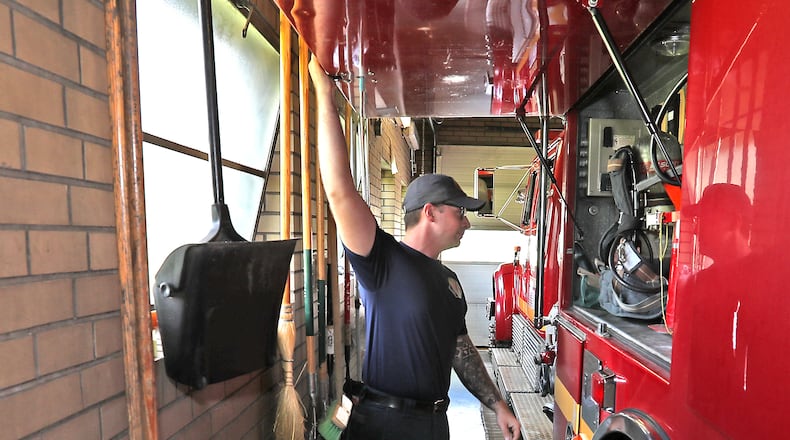Money has not been allocated to the projects, but they have been identified by city staff as good options to receive federal relief dollars.
“We want to be strategic in how we use this money and focus on projects that have a long term investment that we can look back to in the future and see the impact,” said Springfield City Manager Bryan Heck.
City officials say that most of the projects that will be using federal relief dollars where already being talked about before the funds became available.
However, some are solutions to the unintended consequences of the coronavirus pandemic, such as increased homelessness.
Projects that money can be allocated to includes improvements to the waste water and water treatment plants and the proposed building of three new fire stations as well as plans to renovate city hall plaza, add greenspace and make improvements to the parking garage the sits below it.
Construction for some of those projects is slated to start next year and be completed by 2023.
Springfield has already received half of the money slated to be used by the city as part of the American Rescue Plan, with the rest expected to come next year. Officials have until 2024 to determine how that money will be used as the deadline to spend that money is the end of 2026.
The money is part of a $1.9 trillion national plan that seeks to provide relief to municipalities and local governments as well as other institutions reeling from the economic impacts of the coronavirus pandemic.
In addition to replacing lost public sector revenue and helping workers, small businesses and affected industries as well as the hardest hit communities, those funds can be used by governments to invest in water, sewer, broadband systems and addressing the negative economic impact caused by the public health emergency, according to guidance released by the U.S. Treasury Department.
The city has already allocated allocated roughly $3.5 million in spending, with about $2 million going to create more storage space for sludge caused by the city’s wastewater treatment plant.
Heck said that projects the city wants to use the money for fall under the current guidelines shared by the federal government.
However, final guidance from the federal government as well as additional details on what those federal dollars can be spent on have yet to be released, he added.
Heck said that they expected to receive final guidance on American Rescue Plan money in August, but are now hoping to receive it by the end of the year.
In the meantime, city officials have looked at ways the money can be allocated as well as come up with projected costs for city improvements that meet the federal guidelines.
Heck, in a presentation to Springfield commissioners last week, outlined that $18 million could go towards the construction of three new fire stations, $3 million could go to the plaza renovations, $11 million could go towards key infrastructure projects related to water and sewer utilities and $12 million could go to addressing the city’s homeless crisis as well as creating more affordable housing.
New Fire Stations
Springfield Fire Chief Bryan Miller said that the federal relief money will allow them to build three stations during a similar time period, something that would have not been possible before.
The idea is to build new stations that will allow for modernizing facilities used by the division as well as allow for the use of upgraded equipment.
At least two of those new stations are expected to be built on Burt Street and South Limestone Street. Locations are still being scouted for the third station, but city officials are looking at the east and west sides of Springfield as potential spots.
Credit: Bill Lackey
Credit: Bill Lackey
Miller said the city has been looking to replace some of its fire stations for more than a decade. However, projected costs have prohibited them from moving forward.
The city has seven fire stations in use and has over 120 firefighters on staff.
The new stations would replace some that have been in service for decades, including Fire Station 3 on Selma Road, which was built in 1959. That station cannot accommodate newer fire engines since those models are too big.
Miller said the new stations would not only replace existing ones, but it would also allow them to modernize their facilities for a more diverse workforce such as the five female firefighters with the city. That includes new and updated washrooms and other accommodations.
Heck added that they are looking at locations that are strategic and would aid in improving services and reducing response times. He said that the goal is to start construction next year and have new stations online sometime in 2023.
Plaza renovations
Officials are also hoping to use the federal relief money to cover the costs of a project that has been in the works for some time. It would also meet recommendations for the American Rescue Plan dollars that relate to providing more outdoor and greenspace for the community.
Credit: Contributed
Credit: Contributed
The city was looking at ways to add more green space and make structural changes to City Hall Plaza, which has been described as a sea of concreate, before American Rescue Plan funding became available.
City officials discussed plans last year and even presented renditions of what the plaza could look like, including replacing existing concrete, adding more green space, benches, lighting and creating a more open environment as well as making it more accessible to the public.
Renderings and overall goals of the project have not changed much since it was originally discussed by city officials last fall, Heck said.
Those discussions occurred well before the federal relief dollars were an option.
The idea for those upgrades comes as the city has to tear up parts of the plaza to make needed infrastructure repairs to the parking garage located below.
“The plaza serves as the primarily public gathering space in our downtown. As you see in many downtowns there is that focus on a community gathering spot,” Heck told the News-Sun last year.
“The plaza was intended for that when this was constructed back in the (1970s). It has grown tired. It needs to be re-imagined. It needs to be reinvented and to continue to be that public space for our community, for everyone,” he added at the time.
Heck said the garage that sits below the plaza was built in 1979 and is in need of repairs.
Concrete surrounding the garage and plaza has not held up over time and that has resulted in a lot of maintenance costs for the city.
Credit: Contributed
Credit: Contributed
Construction on the plaza is projected to start in 2022 with the use of American Rescue Plan dollars. The hope is that it would either be completed within that same year or extended into 2023.
The plan is to allocate $3 million for renovations and repairs.
Heck said that the project and proposed improvements would be discussed at a city commission work session this month.
Necessary water and sewer infrastructure
City officials have said that $11 million of those funds could go towards several projects that are related to the water and waste water treatment facilities in Springfield.
That includes money already allocated to a project that would utilize city-owned property at 932 Dayton Avenue, which is across the street from the waste water treatment plant.
Plans call for installing two covered storage facilities for sludge, which is residue that accumulates in sewage treatment plants and that project is slated to cost a little more than $2 million.
Sludge that is stored also undergoes a process in which liquids are removed. The project will also include the addition of scales to weigh vehicles.
The project is expected to start this year and will last an estimated 180 days, said Chris Moore, the service director for the city. Land that will be used for the storage facilities has been owned by the city for several years and existing buildings on the property will be demolished.
The city currently stores that sludge at the wastewater treatment plant and will continue to do so, Moore said. However, the building of additional storage sites gives the city more space to hold that sludge, which is trucked away by a contractor and applied to farm fields.
Heck said the project would save the city money in the long run since other alternatives can be costlier. That includes sending it to a landfill.
Another project that would potentially use the federal relief funds is the construction of a building that would be used to store and manage chemicals used at the city’s water treatment plant.
That includes the switch to and the storage of liquid versions of chemicals that are used by the water treatment plant such as chlorine.
The new building will also allow for integration of the feeding of other liquids used in the water treatment process.
The project is expected free up much needed space at the water treatment plant.
The project has not reached the design phase and the city is still determining where the building will be located, how big it will be as well as when construction would start and be completed, Moore said.
However, he said they estimate the budget for the project will be about $4 million.
Helping displaced individuals, creating affordable housing
City officials also want to use American Rescue Plan dollars to tackle an increase in homelessness in the city as well as address a lack of affordable housing options.
Heck said they want to focus on three key strategies such as creating short-term housing opportunities, aiding in the acquisition and rehab of existing properties and aiding in new construction.
The goal is to allocate $12 million in federal relief money for that work.
One of the affects of the pandemic was the increase in the number of people needing emergency shelter. The city has seen a spike in that demand that started early in the pandemic and has continued through this year.
The closing of at least two congregant shelters due to safety concerns related to the spread of COVID-19 has caused a reliance on non congregant options such as motel and hotel rooms.
A waitlist for those services was created last year for the first time in over a decade.
However, Heck said that the reliance on hotel and motel rooms as emergency shelter options is a short-term solution and is not sustainable.
That has caused the city to pursue longer term options that would also address safety concerns caused by the pandemic. That includes looking for nonprofit partners in creating more sustainable non-congregant emergency shelter options.
City officials estimate it would take about $2 million to create more non-congregant shelters in Springfield and an application process was made available in August for interested organizations focused on that type of work.
The idea is to make funding available and partner with a nonprofit for the acquisition and associated costs, as well as necessary renovations, of a facility that will be converted to a center for homeless services.
Other assistance would go towards rehabbing as well as acquiring existing properties and the construction of new affordable housing options that would offer long-term solutions to the problem being faced by the city.
$44.2 million - Amount of money the City of Springfield will be receiving from the American Rescue Plan
2026 - Deadline for when the money is to be spent
$3.5 million -Amount of that federal relief money already allocated by the city
About the Author





